Construction and Calibration of a Unique Hot Box Apparatus
Abstract
1. Introduction and Background
2. Literature Review
3. Description of the Apparatus
3.1. Environment Chambers
3.2. Specimen Frame
3.3. Heating System
3.4. Cooling System
3.5. Radiation Baffles
3.6. Air Circulation Systems
3.7. Temperature Sensors
3.8. Heat Flux Sensors
4. Calibration Procedure
4.1. Temperature Stability
4.2. Experimental, Numerical, and Theoretical Thermal Analyses
- Theoretical calculation: the heat flux was estimated according to Equations (1) and (2), where the average values of the measured temperatures of the specimen surfaces and were employed:
- Numerical analysis: the HEAT3 program was incorporated to estimate the heat flux, where the average values of the measured air temperatures are assumed. In both the theoretical and numerical analysis, the thermal conductivity of the tested samples was assumed to be a constant value equal to 0.028 W/m·K. According to the ASHREA handbook and the ISO 12567-1 standard, the cold (exterior) and hot (interior) sides’ surface film coefficients ( and ) were assumed to be 25 W/m2·K and 7.7 W/m2·K;
- Experimental measurements: the average heat flux value collected using the heat flux sensor was considered. The heat flux sensor is located at the center of the specimen panel. The average value was collected over a period of more than 6 h after reaching the steady-state conditions, as indicated in [23]. In general, the steady state was considered to have been achieved when the temperature measurements in the air curtains started to vary arbitrarily by less than 1.0% over a period of time [24].
4.3. Energy Balance
5. Thermal Characterization of a Clear Wall Assembly
6. Summary of Observations and Conclusions
- Although the temperature of the surrounding space fluctuates by ±1.50 °C, at the steady state, the temperature fluctuation inside the chambers and the temperature variation from point to point across the specimen’s surface remain below ±0.05 °C and 0.20 °C, respectively. These values are the lowest among all studies reported in the literature using a calibrated hot box apparatus;
- During the calibration procedure, the differences between the results obtained experimentally and the ones computed both numerically and theoretically were always below 3.0%;
- Using this apparatus, the thermal evaluation of a representative clear lightweight steel framing (LSF) wall assembly (0.9 m × 0.9 m × 0.28 m) at four different temperature gradients has shown a consistent agreement with the results obtained from the numerical simulations, as:
- ○
- the measured average values of thermal transmittance and resistance were 0.317 W/m2·K and 3.15 m2·K/W, respectively;
- ○
- the numerically simulated average thermal transmittance and resistance values were 0.292 W/m2·K and 3.43 m2·K/W, respectively;
- ○
- the differences between the experimental and numerical results were always less than 9.0%.
Author Contributions
Funding
Institutional Review Board Statement
Informed Consent Statement
Data Availability Statement
Acknowledgments
Conflicts of Interest
References
- Pérez-Lombard, L.; Ortiz, J.; Pout, C. A review on buildings energy consumption information. Energy Build. 2008, 40, 394–398. [Google Scholar] [CrossRef]
- Asdrubali, F.; Bonaut, M.; Battisti, M.; Venegas, M. Comparative study of energy regulations for buildings in Italy and Spain. Energy Build. 2008, 40, 1805–1815. [Google Scholar] [CrossRef]
- ASTM International. Test Method for Steady-State Heat Flux Measurements and Thermal Transmission Properties by Means of the Guarded-Hot-Plate Apparatus; ASTM International: West Conshohocken, PA, USA, 2019. [Google Scholar] [CrossRef]
- ASTM International. Test Method for Steady-State Thermal Transmission Properties by Means of the Heat Flow Meter Apparatus; ASTM International: West Conshohocken, PA, USA, 2017. [Google Scholar] [CrossRef]
- Zarr, R.R. A history of testing heat insulators at the national institute of standards and technology. Ashrae Trans. 2001, 107, 661. [Google Scholar]
- van Dusen, M.S.; Finck, J.L. Heat transfer through building walls. Bur. Stand. J. Res. 1931, 6, 493. [Google Scholar] [CrossRef]
- de Rubeis, T.; Muttillo, M.; Nardi, I.; Pantoli, L.; Stornelli, V.; Ambrosini, D. Integrated Measuring and Control System for Thermal Analysis of Buildings Components in Hot Box Experiments. Energies 2019, 12, 2053. [Google Scholar] [CrossRef]
- Klems, J.H. A Calibrated Hotbox for Testing Window Systems? Construction, Calibration, and Measurements on Prototype High-Performance Windows. 1979. Available online: https://escholarship.org/content/qt76x4x231/qt76x4x231.pdf (accessed on 18 January 2022).
- de Fang, X. A study of the U-factor of the window with a high-reflectivity venetian blind. Sol. Energy 2000, 68, 207–214. [Google Scholar] [CrossRef]
- Wakili, K.G.; Tanner, C. U-value of a dried wall made of perforated porous clay bricks: Hot box measurement versus numerical analysis. Energy Build. 2003, 35, 675–680. [Google Scholar] [CrossRef]
- Mumaw, J.R. Calibrated Hot Box: An Effective Means for Measuring Thermal Conductance in Large Wall Sections. In Heat Transmission Measurements in Thermal Insulations; ASTM International: West Conshohocken, PA, USA, 1974. [Google Scholar] [CrossRef]
- Burch, D.M.; Zarr, R.R.; Licitra, B.A. A Dynamic Test Method for Determining Transfer Function Coefficients for a Wall Specimen Using a Calibrated Hot Box. In Insulation Materials, Testing and Applications; ASTM International: West Conshohocken, PA, USA, 1990. [Google Scholar]
- Sabine, H.J.; Lacher, M.B.; Flynn, D.R.; Quindry, T.L. Acoustical and Thermal Performance of Exterior Residential Walls, Doors, and Windows; National Bureau of Standards: Washington, DC, USA, 1975.
- Miller, R.G.; Perrine, E.L.; Linehan, P.W. A Calibrated/Guarded Hot-Box Test Facility. In Thermal Transmission Measurements of Insulation; ASTM International: West Conshohocken, PA, USA, 1978. [Google Scholar]
- Mumaw, J.R. Thermal research facility—A large calibrated hot box for horizontal building elements. In Thermal Insulation Performance; ASTM International: West Conshohocken, PA, USA, 1980. [Google Scholar]
- Achenbach, P.R. Design of a calibrated hot-box for measuring the heat, air, and moisture transfer of composite building walls. Thermal performance of the exterior envelopes of buildings. Proceedings 1981, 1, 308–324. [Google Scholar]
- Fiorato, A.E. Laboratory Tests of Thermal Performance of Exterior Walls; Thermal Performance of the Exterior Envelopes of Buildings; American Society of Heating Refrigerating and Air-conditioning Engineers and US. Department of Energy Office of Energy Conservation and solar Energy Buildings and Community Systems Division: Kissimmee, FL, USA, 1979; pp. 221–236.
- Perrine, E.L.; Linehan, P.W.; Howanski, J.W.; Shu, L.S. The Design and Construction of a Calibrated/Guarded Hot Box Facility. In Thermal Performance of the Exterior Envelopes of Buildings; ASHRAE SP28; American Society of Heating, Refrigerating, and Air-Conditioning Engineers, Inc.: New York, NY, USA, 1981; pp. 299–307. [Google Scholar]
- Rucker, J.L.; Mumaw, J.R. Calibration procedures and results for a large calibrated hot box. Thermal Performance of the Exterior Envelopes of Buildings. Ashrae SP 1981, 28, 237–249. [Google Scholar]
- Powell, F.J.; Bales, E.L. Design of Round-Robin Tests with Guarded/Calibrated Hot Boxes, Guarded Hot Plates, and Heat Flow Meters. In Thermal Insulation, Materials, and Systems for Energy Conservation in the’80s; ASTM International: West Conshohocken, PA, USA, 1983. [Google Scholar]
- Broderick, T.B. Design and calibration of a guard added to an existing hot box. J. Test. Eval. 1987, 15, 145–152. [Google Scholar]
- Zarr, R.R.; Burch, D.M.; Faison, T.K.; Arnold, C.E.; O’Connell, M.E. Calibration of the NBS calibrated hot box. J. Test. Eval. 1987, 15, 167–177. [Google Scholar]
- ASTM International. Standard Test Method for Thermal Performance of Building Materials and Envelope Assemblies by Means of a Hot Box Apparatus; ASTM International: West Conshohocken, PA, USA, 2019. [Google Scholar]
- ISO 8990:1996 Thermal Insulation. Determination of Steady-State Thermal Transmission Properties. Calibrated and Guarded Hot Box. Available online: https://www.en-standard.eu/bs-en-iso-8990-1996-thermal-insulation-determination-of-steady-state-thermal-transmission-properties-calibrated-and-guarded-hot-box/ (accessed on 16 June 2021).
- Annual Reports. ClimateWorks Foundation. Available online: https://www.climateworks.org/report/annual-reports/ (accessed on 26 January 2022).
- Martin, K.; Campos-Celador, A.; Escudero, C.; Gómez, I.; Sala, J.M. Analysis of a thermal bridge in a guarded hot box testing facility. Energy Build. 2012, 50, 139–149. [Google Scholar] [CrossRef]
- Kus, H.; Özkan, E.; Göcer, Ö.; Edis, E. Hot box measurements of pumice aggregate concrete hollow block walls. Constr. Build. Mater. 2013, 38, 837–845. [Google Scholar] [CrossRef]
- Chen, F.; Wittkopf, S.K. Summer condition thermal transmittance measurement of fenestration systems using calorimetric hot box. Energy Build. 2012, 53, 47–56. [Google Scholar] [CrossRef]
- Schumacher, C.J.; Straube, J.F.; Ober, D.G.; Grin, A.P. Development of a New Hot Box Apparatus to Measure Building Enclosure Thermal Performance. p. 19. Available online: https://web.ornl.gov/sci/buildings/conf-archive/2013%20B12%20papers/212-Schumacher.pdf (accessed on 26 January 2022).
- Asdrubali, F.; Baldinelli, G. Thermal transmittance measurements with the hot box method: Calibration, experimental procedures, and uncertainty analyses of three different approaches. Energy Build. 2011, 43, 1618–1626. [Google Scholar] [CrossRef]
- Ricciardi, P.; Belloni, E.; Cotana, F. Innovative panels with recycled materials: Thermal and acoustic performance and Life Cycle Assessment. Appl. Energy 2014, 134, 150–162. [Google Scholar] [CrossRef]
- Seitz, S.; MacDougall, C. Design of an Affordable Hot Box Testing Apparatus. In Proceedings of the NOCMAT 2015-Construction for Sustainability-Green Materials & Technologies, Mérida, Yucatán, Mexico, 26–29 November 2015. [Google Scholar]
- Buratti, C.; Belloni, E.; Lunghi, L.; Borri, A.; Castori, G.; Corradi, M. Mechanical characterization and thermal conductivity measurements using of a new ‘small hot-box’ apparatus: Innovative insulating reinforced coatings analysis. J. Build. Eng. 2016, 7, 63–70. [Google Scholar] [CrossRef]
- Buratti, C.; Belloni, E.; Lunghi, L.; Barbanera, M. Thermal Conductivity Measurements By Means of a New ‘Small Hot-Box’ Apparatus: Manufacturing, Calibration and Preliminary Experimental Tests on Different Materials. Int. J. Thermophys. 2016, 37, 47. [Google Scholar] [CrossRef]
- Alongi, A.; Angelotti, A.; Mazzarella, L. Experimental investigation of the steady state behaviour of Breathing Walls by means of a novel laboratory apparatus. Build. Environ. 2017, 123, 415–426. [Google Scholar] [CrossRef][Green Version]
- Chowdhury, D.; Neogi, S. Thermal performance evaluation of traditional walls and roof used in tropical climate using guarded hot box. Constr. Build. Mater. 2019, 218, 73–89. [Google Scholar] [CrossRef]
- Barbaresi, A.; Bovo, M.; Santolini, E.; Barbaresi, L.; Torreggiani, D.; Tassinari, P. Development of a low-cost movable hot box for a preliminary definition of the thermal conductance of building envelopes. Build. Environ. 2020, 180, 107034. [Google Scholar] [CrossRef]
- Shen, Z.; Brooks, A.L.; He, Y.; Shrestha, S.S.; Zhou, H. Evaluating dynamic thermal performance of building envelope components using small-scale calibrated hot box tests. Energy Build. 2021, 251, 111342. [Google Scholar] [CrossRef]
- Tejeda-Vázquez, R.; Macias-Melo, E.V.; Hernández-Pérez, I.; Aguilar-Castro, K.M.; Serrano-Arellano, J. Empirical model of hygrothermal behavior of masonry wall under different climatic conditions using a hot box. Energy Build. 2021, 249, 111209. [Google Scholar] [CrossRef]
- Boukhelf, F.; Trabelsi, A.; Belarbi, R.; Bouiadjra, M.B. Experimental and numerical modelling of hygrothermal transfer: Application on building energy performance. Energy Build. 2022, 254, 111633. [Google Scholar] [CrossRef]
- Thermal Insulation. Available online: https://d8-na.industrial.panasonic.com/node/956 (accessed on 2 March 2021).
- Kumaran, M.K. Material Properties; Laboratorium Bouwfysica, Deppartment Burgerlijke Bouwkunde, K.U.-Leuven: Leuven, Belgium, 1996. [Google Scholar]
- Standard Specification for Rubber Cellular Cushion Used for Carpet or Rug Underlay. Available online: https://www.astm.org/d3676-18.html (accessed on 2 March 2021).
- Plywood. Available online: http://www.matweb.com/search/datasheet_print.aspx?matguid=bd6620450973496ea2578c283e9fb807 (accessed on 2 March 2021).
- Simmler, H.; Brunner, S.; Heinemann, U.; Schwab, H.; Kumaran, K.; Mukhopadhyaya, P.; Quenard, D.; Sallee, H.; Noller, K.; Kuecuekpinar-Niarchos, E.; et al. Vacuum Insulation Panels-Study on VIP-Components and Panels for Service Life Prediction of VIP in Building Applications (Subtask A). 2005. Available online: https://www.osti.gov/etdeweb/biblio/21131463 (accessed on 2 March 2021).
- HEAT3—Heat Transfer in Three Dimensions—Buildingphysics.com. Available online: https://buildingphysics.com/heat3-3/ (accessed on 29 January 2019).
- Lavine, A.G.; Rucker, J.L.; Wilkes, K.E. Flanking Loss Calibration for a Calibrated Hot Box. In Thermal Insulation, Materials, and Systems for Energy Conservation in the’80s; ASTM International: West Conshohocken, PA, USA, 1983. [Google Scholar]


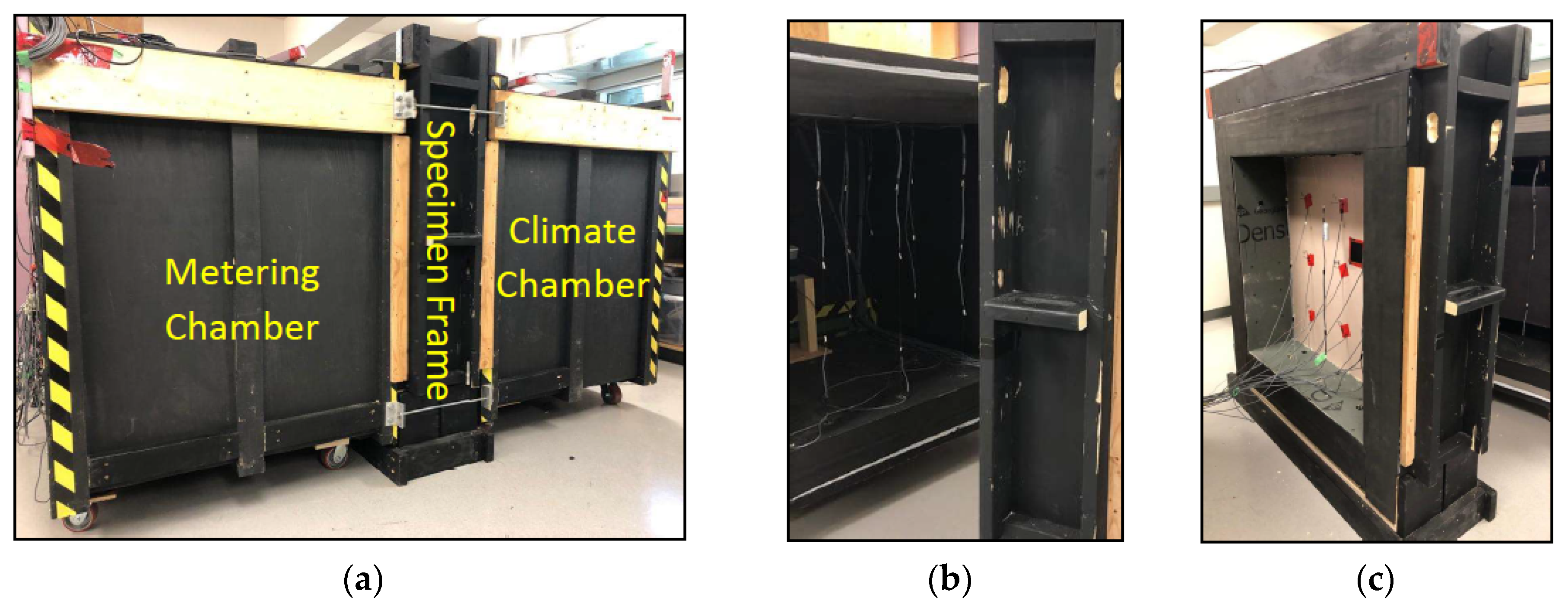
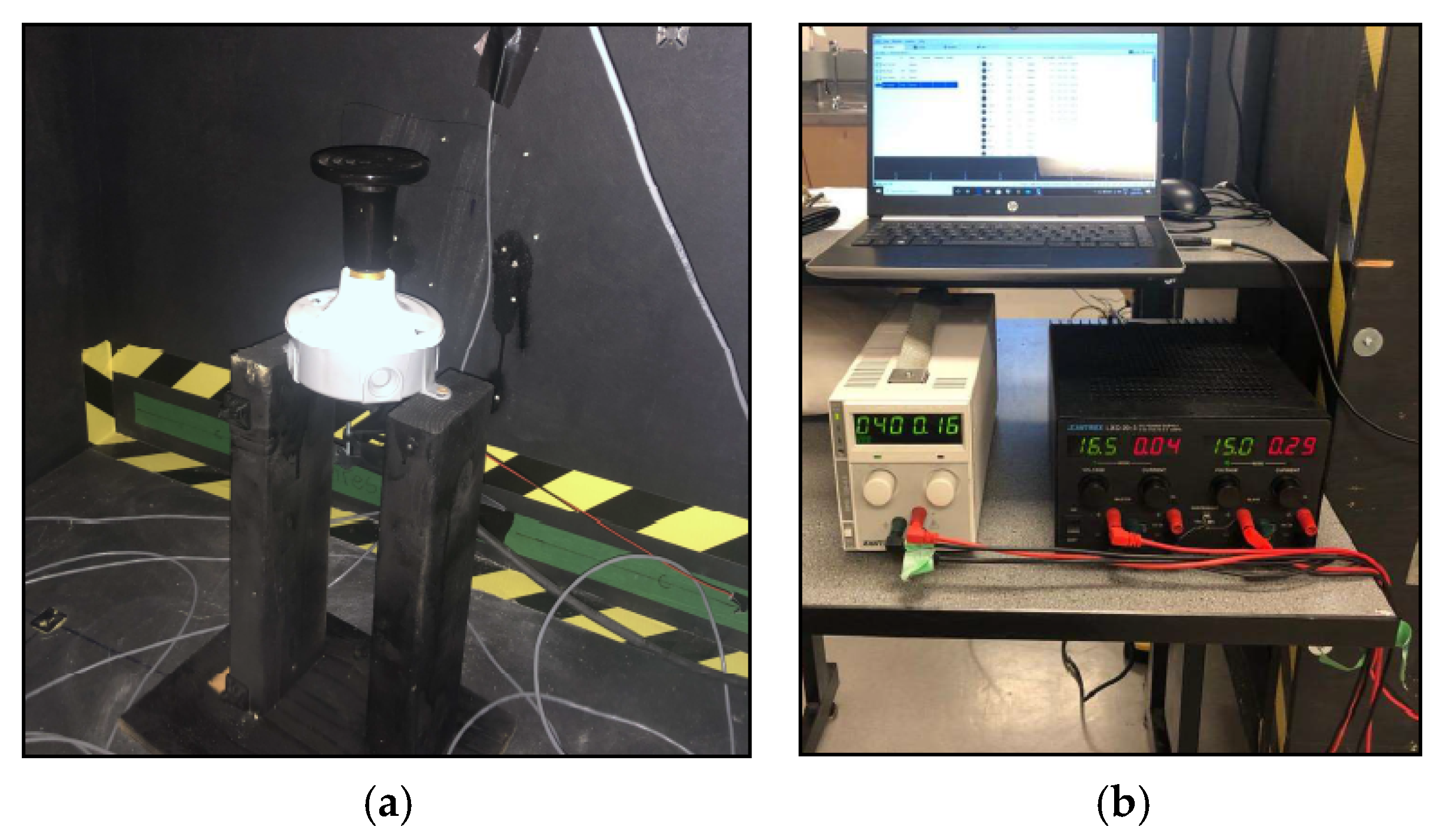
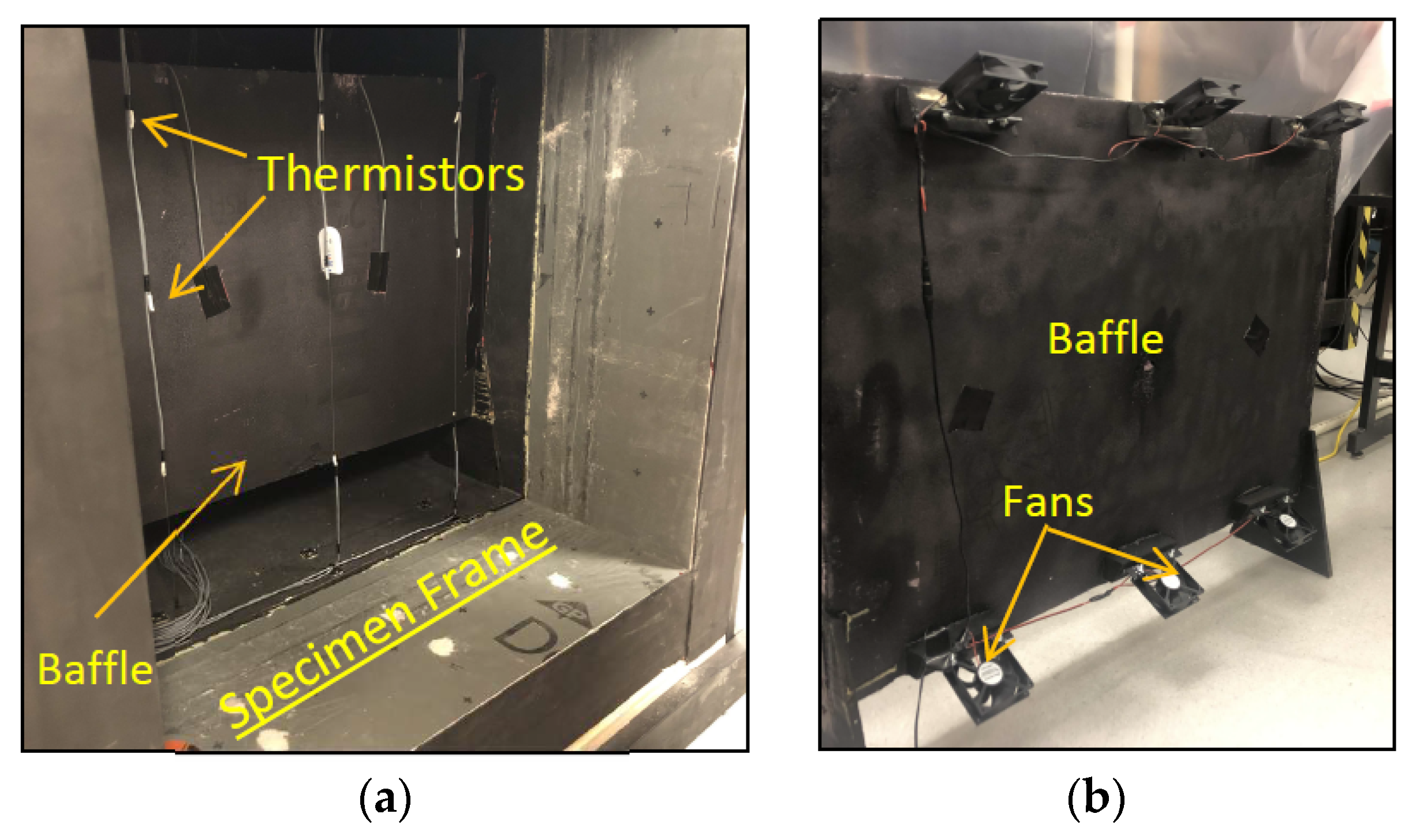
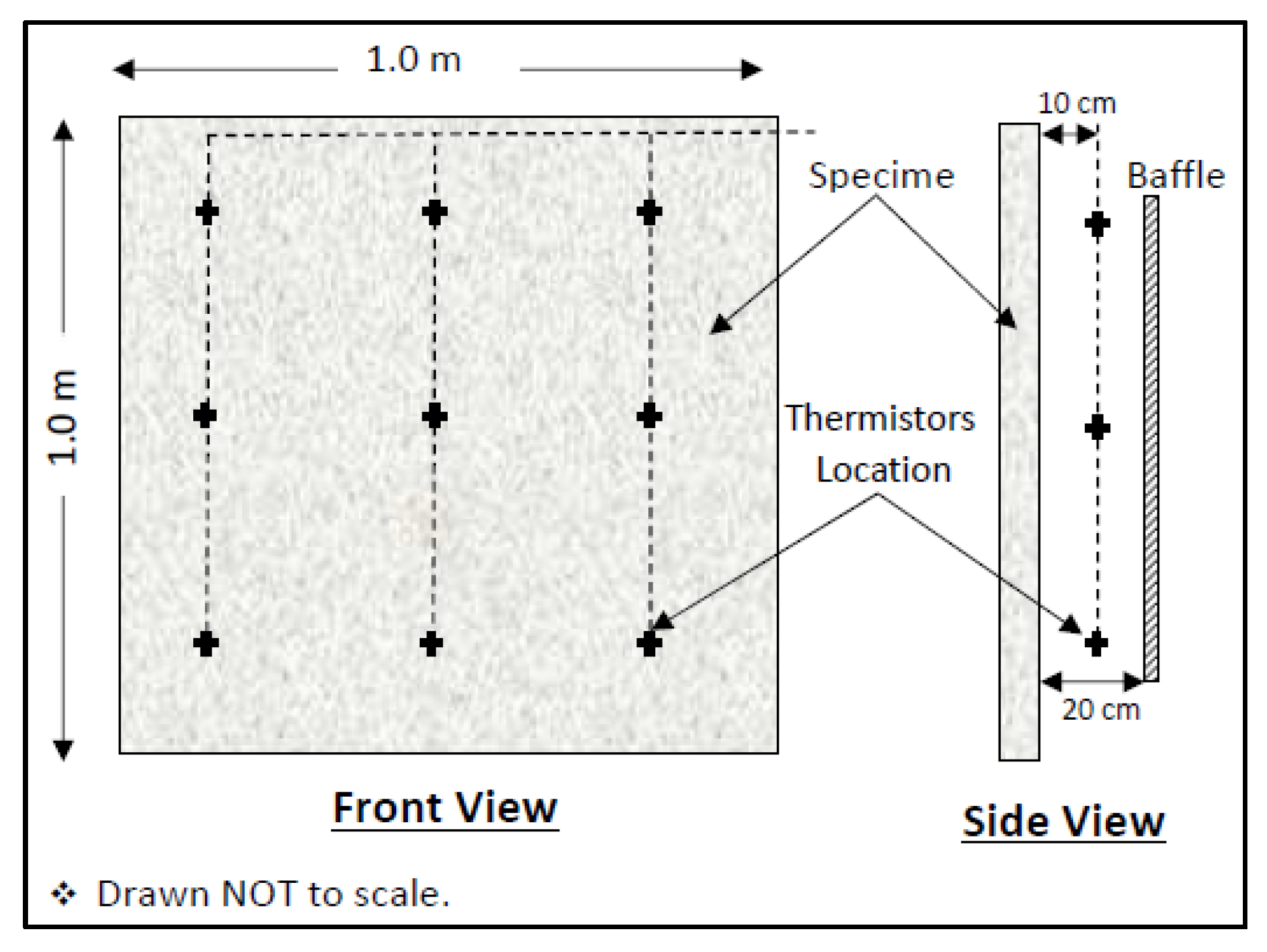
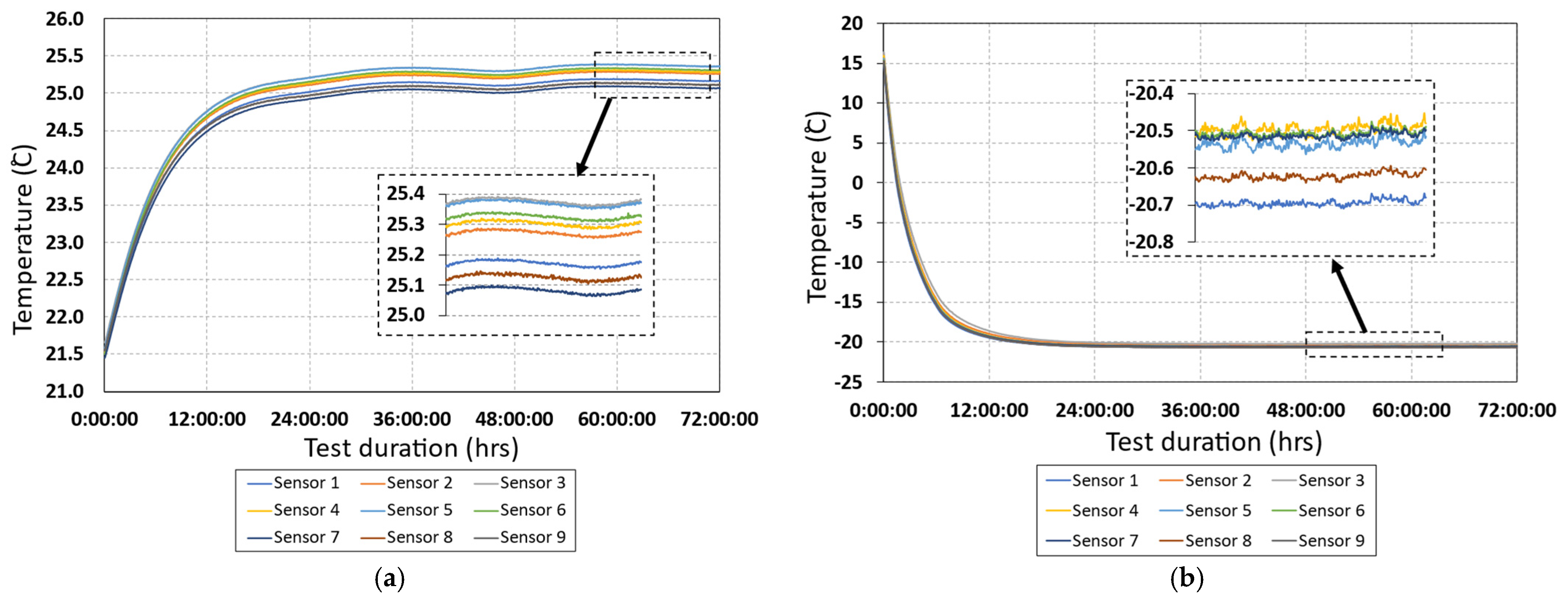
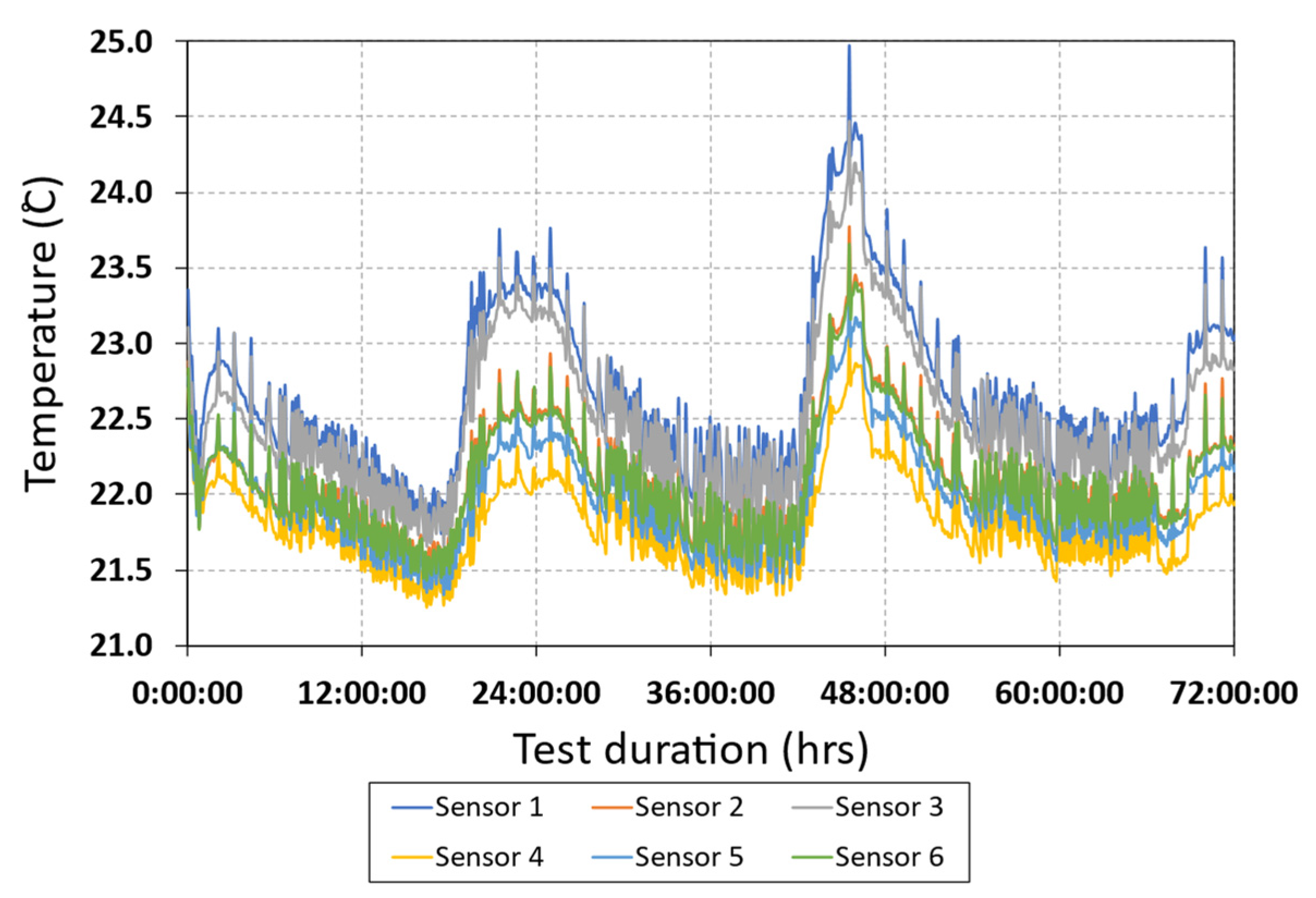
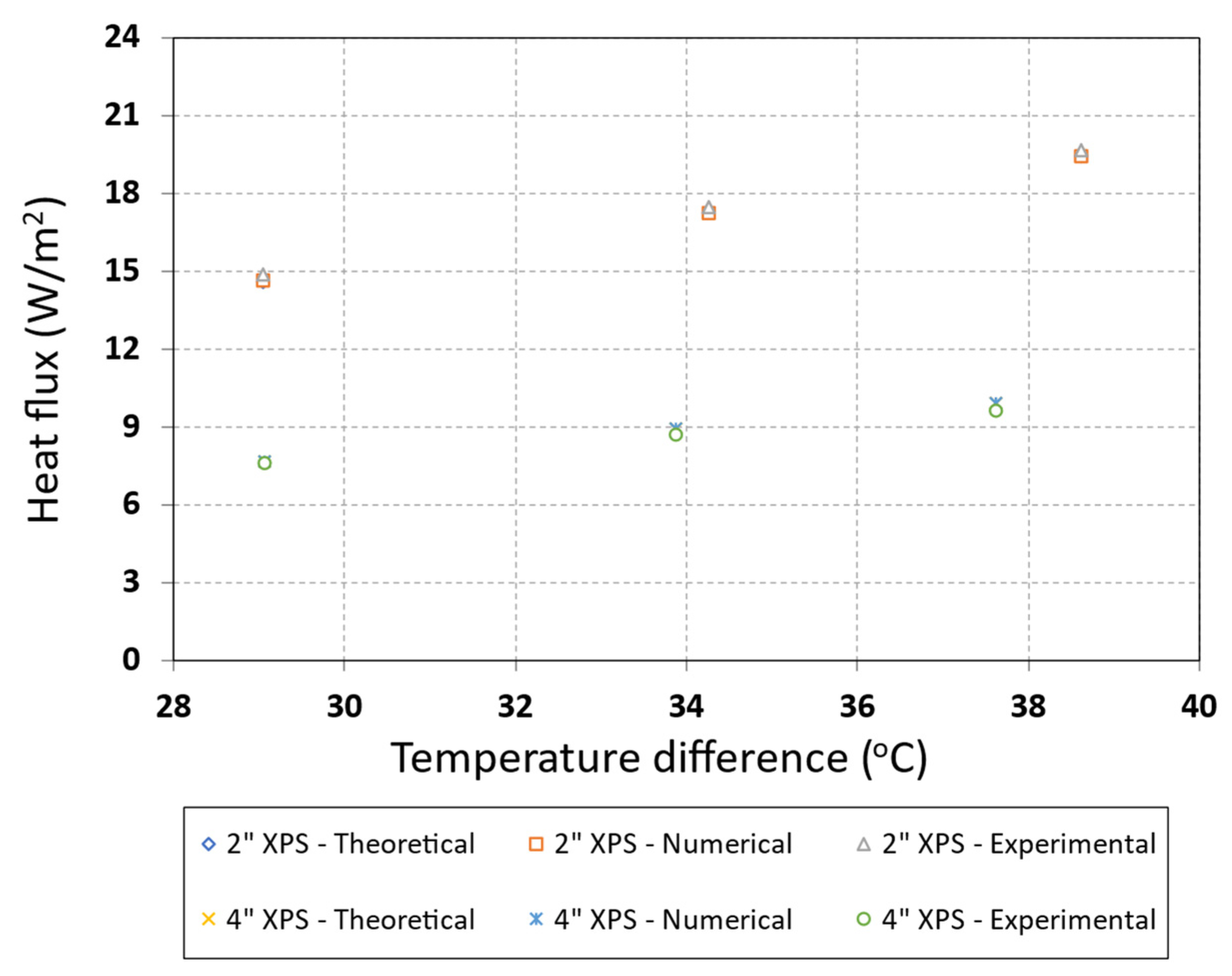
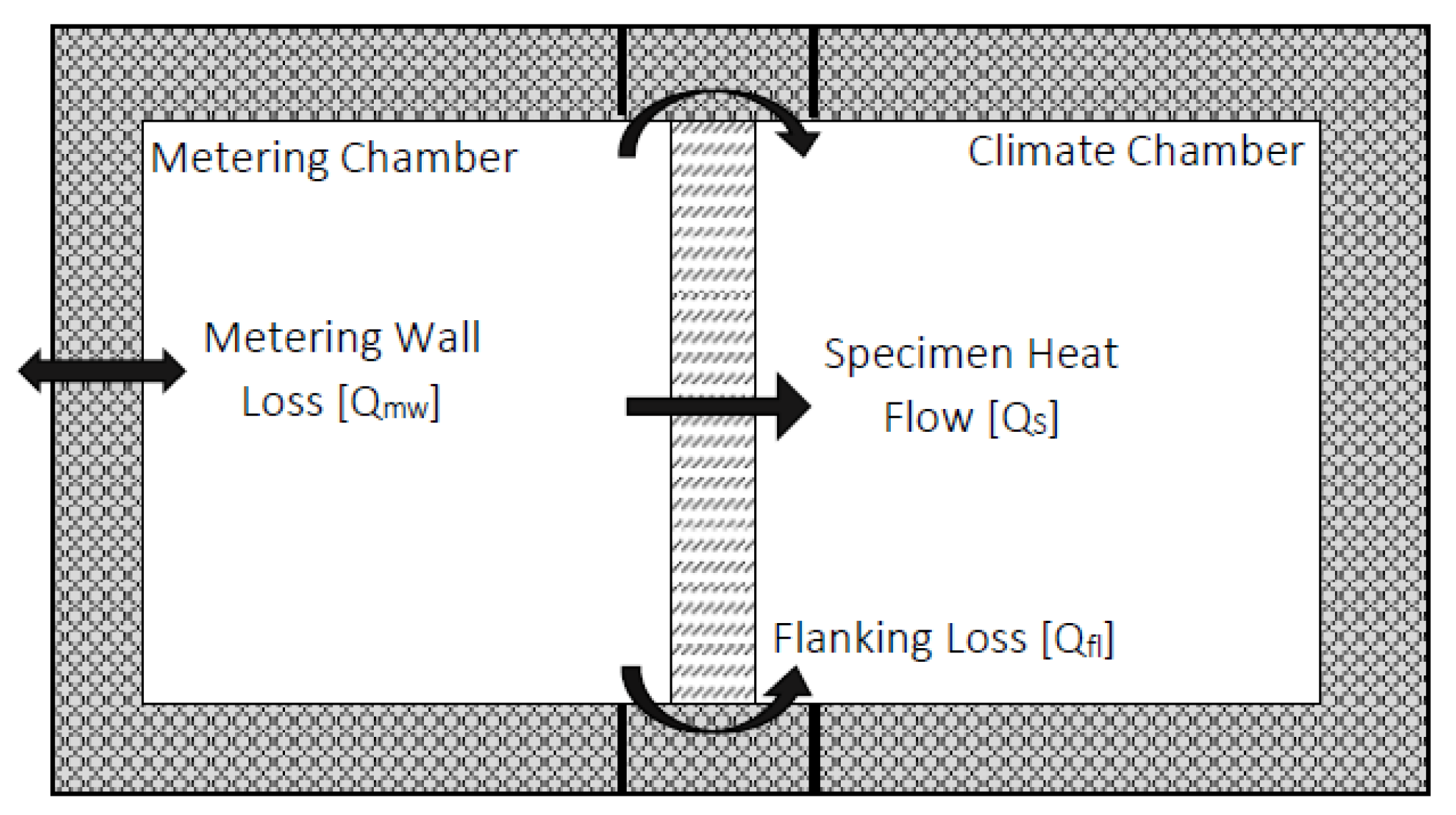
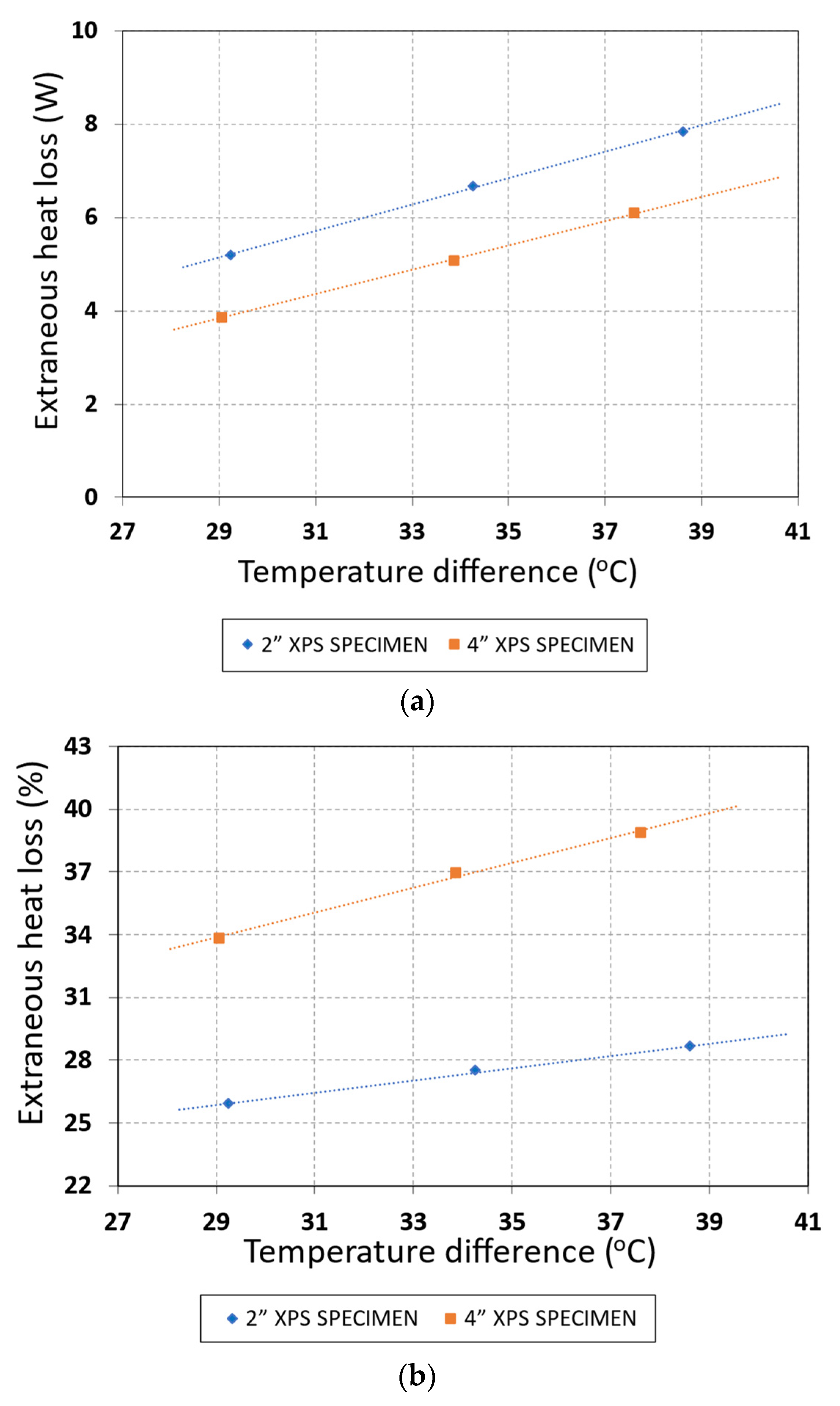
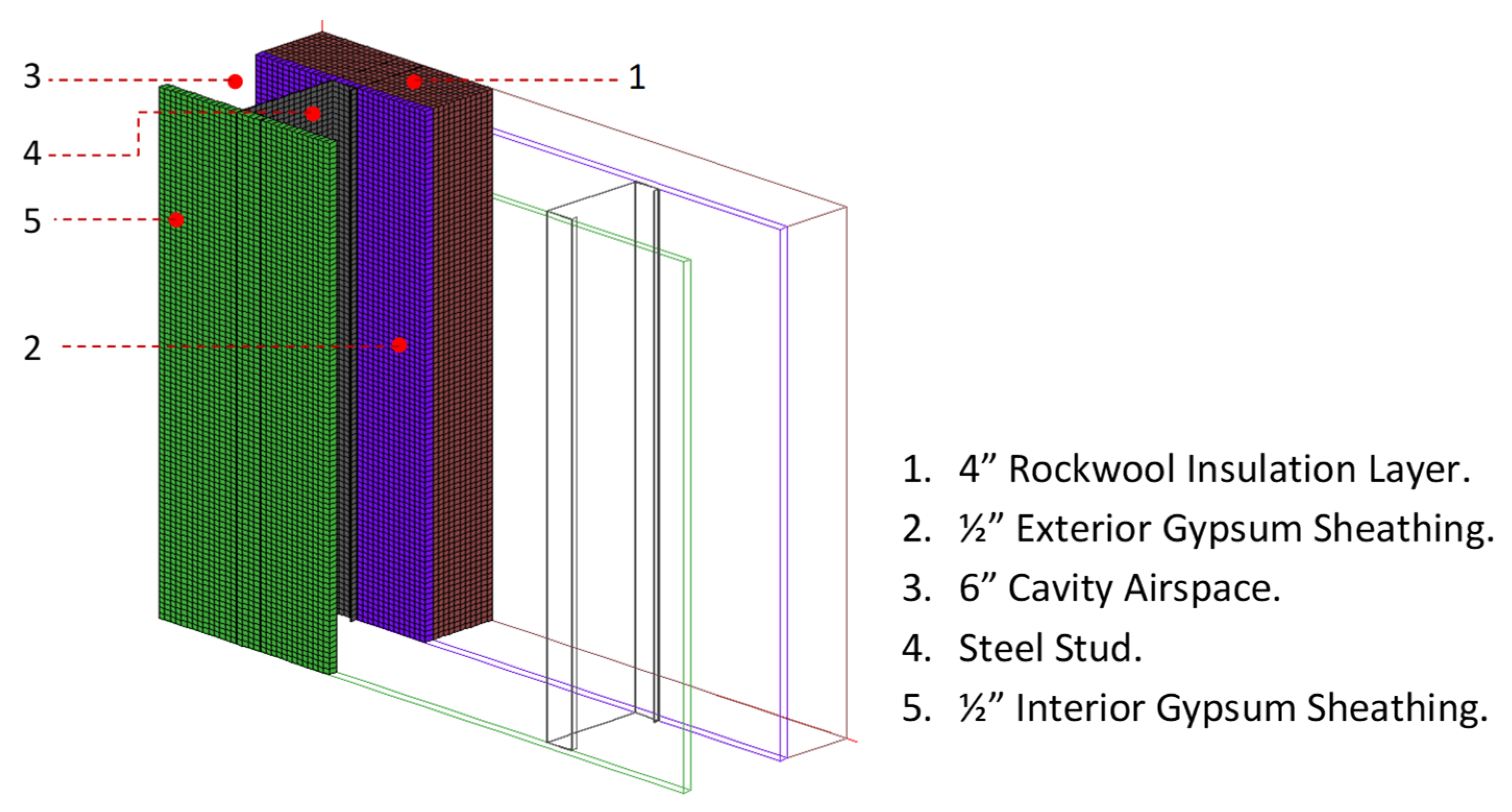
| Publication Authors/Year | Size of Metering Area | Size of Metering Chamber | Apparatus Typology | Thickness of Chamber Walls (Core Materials) | Thermal Resistance of Chambers Walls | Point-to-Point Air Temp. Variation | Max. Temp. Fluctuations at Steady State |
|---|---|---|---|---|---|---|---|
| ASTM C1363 Standard (2019) [23] | >1.50 m2 | >1.50 m2 | GHB/CHB | - | >0.83 m2·K/W (R-4.7) | <2.0% of ∆T; and <2 K | <±0.25 °C |
| ISO 8990 Standard (1996) [24] | >1.50 m × 1.50 m | >1.50 m × 1.50 m | GHB/CHB | - | - | <2.0% of ∆T; and <2 K/m | <1.0% of ∆T |
| Asdrubali, Baldinelli (2011) [30] | 2.70 m × 2.0 m | 2.70 m × 2.0 m | CHB | 240 mm (EPS) | 7.46 m2 K/W (R-42) | - | ±0.2 °C |
| Seitz et al. (2015) [32] | 1.18 m × 1.37 m | 1.18 m × 1.37 m | CHB | 130 mm (EPS) | 2.91 m2 K/W (R-16.5) | <3.0 °C | ±2.0 °C |
| Buratti et al. (2016) [33,34] | 0.46 m × 0.46 m | 0.50 m × 0.50 m | CHB | 220 mm (Polyurethan) | 8.78 m2 K/W (R-50) | 0.4 °C | ±0.1 °C |
| Alongi et al. (2017) [35] | 1.00 m × 1.00 m | 1.22 m × 1.22 m | CHB | 140 mm (Polystyrene) | 4.35 m2 K/W (R-25) | - | ±0.3 °C |
| Chowdhury et al. (2019) [36] | 0.50 m × 0.50 m | 1.75 m × 1.50 m | GHB | 250 mm (XPS) | 8.80 m2 K/W (R-50) | - | ±0.06 °C |
| Barbaresi et al. (2020) [37] | 1.00 m × 1.00 m | 1.00 m × 1.00 m | CHB | 100 mm (EPS) | 2 m2 K/W (R-11.5) | - | ±4.0 °C |
| Shen et al. (2021) [38] | 0.35 m × 0.35 m | 0.44 m × 0.44 m | CHB | 25.4 mm (XPS) | 0.88 m2 K/W (R-5) | - | - |
| Tejeda et al. (2021) [39] | 1.00 m × 1.00 m | Not available | CHB | 50 mm (XPS) | 1.76 m2 K/W (R-10) | - | ±1.0 °C |
| Boukhelf et al. (2022) [40] | 1.30 m × 1.35 m | Not available | CHB | 50 mm (XPS) | 1.76 m2 K/W (R-10) | - | ±0.3 °C |
| Current study | 1.00 m × 1.00 m | 1.00 m × 1.00 m | CHB | 185 mm (XPS + VIP) | 9.15 m2 K/W (R-52) | 0.2 °C | ±0.05 °C |
| Material | Properties | |||
|---|---|---|---|---|
| Density (Kg/m3) | Thermal Conductivity (W/m·K) | Specific Heat Capacity (J/kg·K) | Compressive Strength (kPa) | |
| Extruded polystyrene: XPS-20/XPS-100 | 25/48 | 0.028 | 1470 | 173/690 |
| Vacuum insulation panel (VIP) | 220 | 0.0051 | 850 | 100 |
| Plywood | 550 | 0.125 | 1880 | ~35 × 103 |
| Fiberglass-mat-faced gypsum (DENSGLASS®) | 700 | 0.128 | 880 | 3445 |
| Neoprene foam | 160 | 0.0384 | 2500 | 25 |
| Parameters | Units | 2″ XPS Specimen | 4″ XPS Specimen | ||||
|---|---|---|---|---|---|---|---|
| Test 1 | Test 2 | Test 3 | Test 1 | Test 2 | Test 3 | ||
| Metering Chamber Air Temperature | °C | 21.13 | 21.75 | 21.65 | 20.88 | 21.1 | 21.65 |
| Climate Chamber Air Temperature | °C | −7.91 | −12.51 | −16.96 | −8.18 | −12.76 | −15.96 |
| Specimen Hot Surface Temperature | °C | 19.97 | 20.39 | 20.13 | 20.25 | 20.38 | 20.86 |
| Specimen Cold Surface Temperature | °C | −6.46 | −10.78 | −15.01 | −7.43 | −11.90 | −14.97 |
| Calculated Heat Flow Rate | W/m2 | 14.57 | 17.18 | 19.37 | 7.64 | 8.91 | 9.81 |
| Simulated Heat Flow Rate | W/m2 | 14.6 | 17.22 | 19.4 | 7.62 | 8.88 | 9.87 |
| Measured Heat Flow Rate | W/m2 | 14.82 | 17.44 | 19.63 | 7.55 | 8.67 | 9.61 |
| Difference Between Measured and Calculated | W/m2 (%) | −0.25 (−1.72) | −0.26 (−1.51) | −0.26 (−1.34) | 0.09 (1.18) | 0.24 (2.69) | 0.28 (2.83) |
| Difference Between Measured and Simulated | W/m2 (%) | −0.22 (−1.51) | −0.22 (−1.28) | −0.23 (−1.19) | 0.07 (0.92) | 0.21 (2.36) | 0.26 (2.63) |
| Parameters | Units | 2″ XPS Specimen | 4″ XPS Specimen | ||||
|---|---|---|---|---|---|---|---|
| Test 1 | Test 2 | Test 3 | Test 1 | Test 2 | Test 3 | ||
| Temperature Difference | °C | 29.25 | 34.26 | 38.61 | 29.06 | 33.86 | 37.61 |
| Mean Temperature | °C | 6.62 | 4.62 | 2.35 | 6.35 | 4.17 | 2.85 |
| Measured Heat Flow via the Specimen | W | 14.82 | 17.44 | 19.63 | 7.55 | 8.67 | 9.61 |
| Total Supplied Energy into Metering Chamber | W | 20 | 24.05 | 27.51 | 11.41 | 13.75 | 15.72 |
| Amount of Extraneous Heat Loss | W | 5.18 | 6.61 | 7.88 | 3.86 | 5.08 | 6.11 |
| Percentage of Extraneous Heat Loss * | % | 25.90 | 27.48 | 28.64 | 33.83 | 36.95 | 38.87 |
| Parameters | Units | Test 1 | Test 2 | Test 3 | Test 4 | Test 5 |
|---|---|---|---|---|---|---|
| Average air temperature in metering chamber | °C | 22.31 | 22.73 | 22.65 | 21.77 | 24.33 |
| Average air temperature in climate chamber | °C | −1.63 | −4.76 | −9.36 | −14 | −18.13 |
| Total amount of heat transfers between chambers | W | 7.90 | 9.07 | 10.56 | 11.80 | 14 |
| Net amount of heat transfers via specimen | W | 5.67 | 6.50 | 7.57 | 8.46 | 10.04 |
| Amount of flanking heat loss * | W (%) | 2.23 (28.23) | 2.57 (28.34) | 2.99 (28.31) | 3.34 (28.31) | 3.96 (28.29) |
| The overall thermal resistance (RSI) | m2·K/W | 3.42 | 3.43 | 3.43 | 3.42 | 3.43 |
| Parameters | Units | Test 1 | Test 2 | Test 3 | Test 4 | Test 5 |
|---|---|---|---|---|---|---|
| Amount of supplied energy | W | 8.55 | 10.65 | 12.09 | 14.55 | 17.10 |
| Average air temperature of surrounding space | °C | 22.30 | 22.08 | 22.10 | 20.11 | 22.60 |
| Average air temperature of metering chamber | °C | 22.31 | 22.73 | 22.65 | 21.77 | 24.33 |
| Average air temperature of climate chamber | °C | −1.63 | −4.76 | −9.36 | −14 | −18.13 |
| Amount of metering heat loss * | W | 0 | 0.71 | 0.60 | 1.81 | 1.88 |
| Amount of flanking heat loss | W | 2.41 | 2.82 | 3.25 | 3.61 | 4.30 |
| Net amount of heat transfers via the specimen | W | 6.14 | 7.13 | 8.24 | 9.14 | 10.91 |
| The overall thermal transmittance | W/m2·K | 0.316 | 0.320 | 0.318 | 0.315 | 0.317 |
| The overall thermal resistance (RSI) | m2·K/W | 3.16 | 3.12 | 3.15 | 3.17 | 3.15 |
Publisher’s Note: MDPI stays neutral with regard to jurisdictional claims in published maps and institutional affiliations. |
© 2022 by the authors. Licensee MDPI, Basel, Switzerland. This article is an open access article distributed under the terms and conditions of the Creative Commons Attribution (CC BY) license (https://creativecommons.org/licenses/by/4.0/).
Share and Cite
Alhawari, A.; Mukhopadhyaya, P. Construction and Calibration of a Unique Hot Box Apparatus. Energies 2022, 15, 4677. https://doi.org/10.3390/en15134677
Alhawari A, Mukhopadhyaya P. Construction and Calibration of a Unique Hot Box Apparatus. Energies. 2022; 15(13):4677. https://doi.org/10.3390/en15134677
Chicago/Turabian StyleAlhawari, Abdalhadi, and Phalguni Mukhopadhyaya. 2022. "Construction and Calibration of a Unique Hot Box Apparatus" Energies 15, no. 13: 4677. https://doi.org/10.3390/en15134677
APA StyleAlhawari, A., & Mukhopadhyaya, P. (2022). Construction and Calibration of a Unique Hot Box Apparatus. Energies, 15(13), 4677. https://doi.org/10.3390/en15134677






